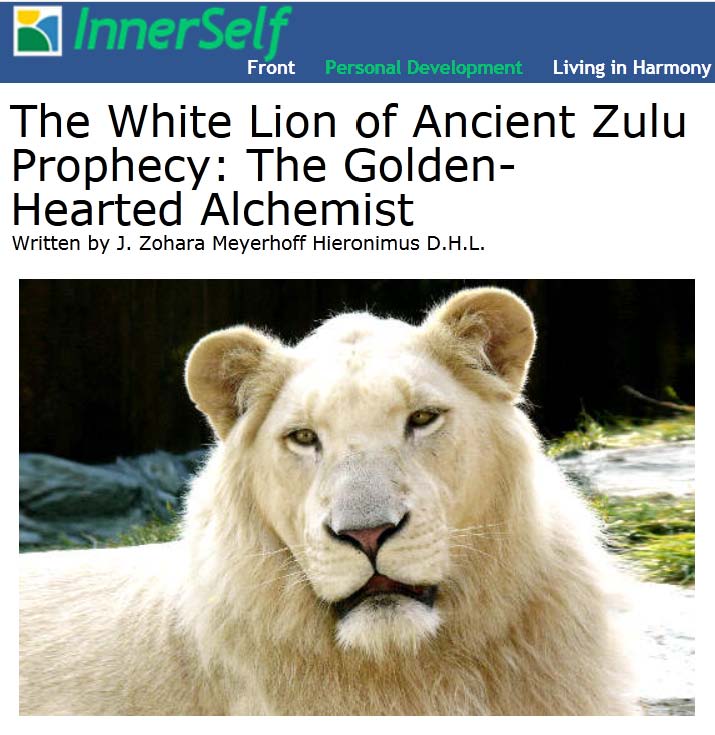 Photo credit: Stano Novak, CC BY 2.5
Photo credit: Stano Novak, CC BY 2.5
No matter who we are, no matter
in which part of the world we dwell, we are one.
We are one with each other. We are one with the Earth.
We are one with the moon, the sun, and the stars.
–Vusamazulu Credo Mutwa, Zulu Lion Shaman
In the land where trees are called “growing people” and ancestral spirits are consulted in community decisions, we meet the White Lions of Timbavati, South Africa.
Like indigenous leaders in whose homeland other White Spirit Animals are born, here too, in Africa, Zulu elders teach that there is vital significance in the appearance of the White Lions in Timbavati at this time. As with all the other White Spirit Animals, the White Spirit Lions have come to warn us of dramatic Earth changes, encouraging us to work together in these perilous times. Protecting the Earth, as Lions have protected humans throughout time, is our noble-hearted duty.
The African White Lions are regarded as animals from the last ice age and their white color is considered testimony of those conditions. One traditional explanation given to the White Lion’s stature stems from when, it is described, all of humanity suffered from disease and famine and the “anger of Mother Nature.” During those desperate times, tradition teaches, the people prayed all night and day. In response, the gods sent down the White Lions to teach the people how to survive, how to hunt, how to keep warm in the bitter, wild cold. Their mission of helping humankind during profound Earth changes is shared with Bear and the other White Spirit Animals.
Native legends recount that the White Spirit Lions, after helping the impoverished and stricken humanity overcome their adversities, left, promising only to return when humankind is in danger once again. And so they have returned. First observed in the 1930s and 1940s, and later in 1975, the White Lions’ reappearance in the twentieth century affirms ancient Zulu prophecy.
With Earth changes upon us from war and climate disruptions, millions of people are currently moving around the planet looking for both food and shelter, and there is a developing food scarcity in major cities around the world whose export polices have bankrupted food supplies in their native lands. World Wildlife Fund’s CEO Carter Roberts states, “We’re gradually destroying our planet’s ability to support our way of life. . . . We know that we all live on a finite planet and it’s time that we started acting within those limits.”
Taking Responsibility with Love and Compassion for All Life
Conservation means taking responsibility worldwide and enacting practices in each locale that show love and compassion for all life. It was prophesized that the White Lions would return when humanity was on the verge of disaster. Apparently, now is that time.
The White Animals are messengers of change. They are wisdomkeepers and chroniclers of Earth events much like human historians. They speak to the ancient past and the vast, unfolding future. Similar to human prophets who warn of great challenges or pending calamities, they also teach that the impacts of these events can be attenuated. Credo Mutwa, Africa’s preeminent Isanusi (high-ranking shaman) and Guardian of Umlando (the “Great Knowledge”), says, “Today we live in the most important time for human beings. We live in a time of catastrophes and real miracles.”
The Maasai Lion Guardians
Heart intelligence can help us transform past destructive practices into approaches that sustain and elevate life. The Lion Guardians organization, founded in 2007 by Leela Hazzah and Stephanie Dolrenry, is an important example of transformation in Africa.
The Maasai of East Africa live in present-day Kenya and northern Tanzania. For centuries, they have hunted lions as part of their initiation into manhood. The Lion’s imminent extinction has not stopped these rituals. But Lion Guardians offers an alternative manhood initiation by emulating another Lion quality, that of protector.
The Maasai live a mostly pastoral life and depend on their livestock to feed their families. If they lose any of their livestock to lions, or believe that it was from lions, they retaliate by killing lions. Lion Guardians helps return lost livestock, rebuilds animal fencing, tracks lions, and notifies herders when Lions are near, enabling them to take different routes. They employ sixty-five Lion Guardians throughout East Africa, who are paid the equivalent of $100 a month, taught to read and write, and tasked with tracking, naming, and knowing the whereabouts of the Lions they protect. Their ultimate goal is to prevent any conflict with Lions and to reduce Lion killings, increasing their now dangerously small populations.
In the past fifty years Africa has lost 50 percent of its Lion population. But in Amboseli, Kenya, the Lion Guardians have documented a near tripling of the Lion population since beginning their work.
Here we see that an ethos of care rather than exploitation and destruction can change a death economy to a life-elevating economy, enlisting members of local communities to reshape and redefine their relationship to their own environment and its populations, human and animal.
As the symbolic alchemist, Lion reminds us that protecting the Earth is our noble-hearted purpose.
Read the article online at InnerSelf.